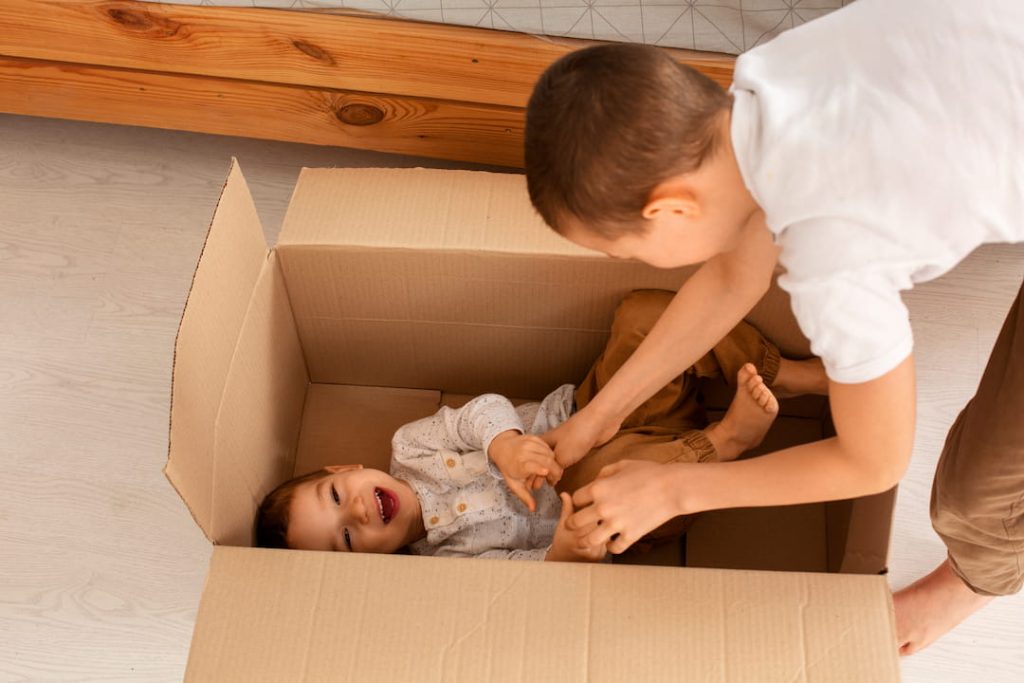Moving with a baby (or toddler) is a challenge that many families face – and it can feel daunting. You’re not just moving house with a baby, you’re juggling nap schedules, diapers, and maybe a few meltdowns along the way. The good news is, with the right preparation and mindset, you can make the process a lot smoother. Here are 10 essential tips for moving with a little one that will help your family transition to your new home with less stress.
1. Consult Your Pediatrician Early
As soon as you know you’ll be relocating, loop in your baby’s doctor. Schedule a check-up to ensure your infant is up-to-date on vaccinations and ask for copies of medical records. Let the pediatrician know about the move – they might offer advice for keeping your baby healthy during the transition. If you’re moving to a new city, get recommendations for a pediatrician in the new area before you move. Having a new doctor lined up is a lifesaver if your baby gets ill shortly after the move (which can happen due to travel or stress). In short, prioritize your baby’s health needs in your moving plan.
2. Plan Ahead, But Don’t Pack the Nursery Too Soon
Good planning is key to any successful move. Create a moving checklist and timeline that includes all your tasks – from booking a moving company and setting a budget to baby-proofing the new house. Start packing early except for the baby’s items. Keep the nursery intact until the final week before moving day if you can. Babies feel secure with familiar surroundings; plus, you don’t want to dig through boxes for that favorite teddy bear or the sleep sack you suddenly need. Gather plenty of moving supplies in advance (boxes, tape, bubble wrap, markers). Aim to pack when your baby is sleeping if possible, so the commotion doesn’t upset their routine.
💡 Pro tip: If you can, take a day off work (while your baby is at daycare or with a sitter) dedicated to packing. A focused day of packing without a little one underfoot can significantly speed up the process. Learn more in our packing guide.
3. Pack Smart and Safely
When you do pack, do it with a “baby lens.” Use sturdy boxes and don’t overfill them – especially with baby gear that might be bulky or heavy (like that jumper or the wipe warmer). Label each box clearly on multiple sides. This will help you or the movers know exactly where the baby’s stuff goes in the new house. Disassemble large furniture like cribs or playpens ahead of time and keep all the screws/parts in a labeled bag taped to the item. If your baby is mobile (crawling or walking), be mindful of packing hazards: stray bits and sharp packing tools should be kept well out of reach. Consider packing one room at a time and closing it off, so curious little explorers don’t get into mischief. And remember, some clutter and mess are inevitable during a move – just try to keep the baby’s environment as safe and calm as you can.
4. Prepare a “Baby Essentials” Kit

Imagine it’s the first night in your new home and you’re surrounded by boxes. What do you not want to be doing? Rummaging through 10 boxes to find the baby’s pajamas or the bottle brush. Avoid this by packing a separate essentials kit for your baby. This could be a suitcase or a clearly marked box that stays with you (not on the moving truck). Include everything your little one will need for the first 24–48 hours: diapers and wipes, changing pad, a few favorite toys or books, pajamas and clothes for a couple of days, bottles and formula (or breastfeeding supplies), baby food and snacks, bibs, bath items, any medications, and definitely the lovey or blanket that comforts them. Keep this kit in your car or somewhere easily accessible upon arrival. This way, you can take care of all your baby’s immediate needs without having to unpack a thing on day one. Bonus: it gives you peace of mind knowing you have all the critical items at hand during travel.
5. Arrange Childcare (and Help) for Moving Day
One of the best tips for moving with a baby is this: don’t do it alone. If possible, enlist help to make the process safer and smoother. Have a trusted friend or family member watch the baby on moving day, or hire a babysitter/nanny for those hours. This allows you to focus on supervising the move, directing movers, and handling last-minute tasks without also having to entertain or constantly watch an infant. It keeps your baby safe from the chaos (and prevents any accidental door-dash by a toddler or a fall in a room filled with boxes). In addition to childcare, consider hiring professional movers for the heavy lifting. Moving furniture and dozens of boxes is tough work – doing that while also caring for a baby is nearly impossible. Professional movers will handle the logistics so you can tend to your child when needed and settle your own nerves. It’s an added expense, but if it fits your budget, it’s money well spent for your sanity and your baby’s safety. Remember, moving day will be hectic; having extra hands (to carry boxes or to cuddle the baby) is truly invaluable.
6. Make Travel Baby-Friendly
If your move involves travel by car or plane, plan it out with your smallest passenger in mind. For road trips, map out a route with frequent stops – try to align them with your baby’s feeding schedule or diaper-change intervals. This gives everyone a break and keeps the baby from getting too cranky being stuck in a car seat for long stretches. Pack the car with an easily reachable baby bag (which is essentially your essentials kit) so you can do quick changes or feedings without unpacking everything. Bring along some new small toys or snacks to distract and delight your little one during the journey. If you’re driving, never put your baby (or any child) in a moving truck’s cab – those vehicles often aren’t equipped for proper car seat installation. Instead, one adult can drive the personal car with the baby safely strapped in the backseat, while another drives the moving truck or you hire professionals for transport. For long drives, also be prepared for flexibility: babies might have an unexpected blowout or meltdown requiring an unscheduled stop, and that’s okay. Build some cushion into your travel time.
💡 Moving trucks are not designed for car seat installation. The National Highway Traffic Safety Administration (NHTSA) strongly advises that children under 13 ride only in the back seat of a car, never in a moving truck.
If you’re flying, check the airline’s policies on traveling with infants. Most airlines allow you to check a car seat and stroller at the gate for free – which is a big help. Plan to carry on extra diapers, clothes, and feeding supplies in case of delays. Booking a nonstop flight (or the shortest travel time possible) is worth it to reduce hassle. And whether by plane or car, try to stick to your baby’s nap times and routines on the travel days – a familiar rhythm can keep them calmer even in unfamiliar environments.
✈️ Traveling by Plane? The TSA allows you to bring formula, breast milk, baby food, and juice in quantities over 3.4 oz, as long as they’re declared and screened (Source).
7. Keep Routines as Consistent as Possible
During a move, so much is changing around your baby. One way to help them (and you) cope is to hold on to your normal routines. Babies and toddlers thrive on consistency. Wherever you are – in a hotel room, at Grandma’s house, or amid boxes in your new living room – try to do meals, naps, and bedtime at the usual times. Pack your baby’s bedtime books, the same pajamas, the white noise machine, or any part of the nightly ritual that signals “sleepy time.” Maintaining these little routines provides a sense of security. Of course, some flexibility is fine (and necessary when traveling across time zones, for example), but generally sticking to your schedule will help prevent the baby from becoming too disoriented or fussy. Also, stay calm and positive as much as you can. Little ones are remarkably good at picking up on stress. If you’re extremely anxious, your baby might be harder to soothe. Taking deep breaths, speaking in reassuring tones, and even turning packing into a playful activity can ease the emotional temperature for everyone.
8. Set Up the Baby’s Space First at the New Home
When you arrive at your new home, make the nursery or baby’s corner your top priority. Unpack and arrange the crib or bassinet, changing station, and a few familiar toys or decorations right away. Even if the rest of the house is a sea of boxes, having the baby’s room set up will give you and your child a much-needed sanctuary the first night. It also means you have a safe spot to put the baby for naps or playtime while you tackle other unpacking tasks. Baby-proofing should happen immediately as well. Before your little explorer starts crawling around the new space, do a safety sweep: cover electrical outlets, secure any dangling blind or curtain cords out of reach, set up baby gates if there are stairs, and keep boxes or hazards out of common play areas. If you disassembled furniture, ensure bookshelves or dressers are re-anchored to the walls. Check the floor for any small objects that might have fallen during moving (screws, push pins, bits of packing tape) and clear them away. It’s a lot to think about on day one, but taking these safety steps early will let you relax a bit more knowing your child is protected in the new home.
9. Newborns vs. Toddlers: Adjust Your Approach
Every age comes with its own moving challenges. If you’re moving with a newborn baby, the biggest thing to remember is to take it easy on yourself. Newborns require constant care (frequent feedings, diaper changes, and they sleep on irregular schedules). It might be unrealistic to get a ton of moving tasks done with a brand-new baby – so if possible, enlist extra help or schedule the move for when your baby is a couple of months old. Also, factor in mom’s recovery if this move is happening right after childbirth. Don’t hesitate to delegate tasks – for the first weeks postpartum, lifting heavy boxes is a no-go. Focus on caring for the baby and yourself; let friends, family, or movers handle the physical strain. On the bright side, newborns are pretty portable and won’t be as aware of the move itself, so moving before they become mobile can sometimes be easier.
On the other hand, moving with a toddler can be a bit of a high-energy adventure. Toddlers have big feelings and loads of curiosity. They might get excited about boxes and “helping,” or they might resist the change and act out. It helps to involve them in small ways – for example, let your toddler put their stuffed animals in a box (under supervision) or be “in charge” of taping a box shut (with a little help). Talk to them about the move in simple terms: show photos of the new house, and if possible, visit it virtually or in person so it’s not completely unknown. During the actual move, have someone keep an eye on the toddler with activities at a safe distance from the moving commotion. Keep favorite snacks and comfort items handy to smooth over cranky moments. Once at the new home, quickly set up something familiar in their room (favorite bedding or toys) to show them “here’s your space.” Toddlers may take a few days or weeks to adjust to new surroundings – expect some sleep disruptions or clinginess. Patience, extra cuddles, and maintaining those routines (story time, play time, etc.) will help them settle in.
10. Take Care of Yourself and Embrace the Journey
Finally, remember that moving is hard, especially with young children, but it’s also the start of an exciting new chapter for your family. Amid all the planning and worry, try to find moments to take care of your own needs too. Stay hydrated, have healthy snacks available (moving day is not the time to accidentally skip lunch!), and if you can, tag-team with your partner or helper to grab short breaks. Celebrate small victories: every box packed or unloaded is progress. When things don’t go perfectly – the baby is having a meltdown or a nap goes out the window – take a deep breath and remind yourself that this is temporary. You will get through it. Once you’re in your new home and gradually returning to normalcy, you’ll feel proud that you managed a move with your baby in tow.
In conclusion, moving with a baby or toddler will always have its stressful moments, but with these tips and a bit of planning, you can significantly minimize the chaos. From one parent to another, know that it can be done smoothly. Lean on your support network, stay flexible, and don’t forget to laugh when you can (like when your toddler decides an empty moving box is their new playhouse!). Soon enough, you’ll be settled into your new place, making wonderful memories with your family. Happy moving – and enjoy this new adventure together!


